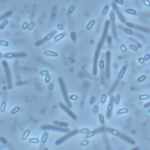Link to Pubmed [PMID] – 9466260
Mol. Microbiol. 1998 Jan;27(1):107-20
The Clostridium difficile toxA and toxB genes, encoding cytotoxic and enterotoxic proteins responsible for antibiotic-associated colitis and pseudomembranous colitis, were shown to be transcribed both from gene-specific promoters and from promoters of upstream genes. However, the gene-specific transcripts represented the majority of tox gene mRNAs. The 5′ ends of these mRNAs were shown to correspond to DNA sequences that had promoter activity when fused to the Escherichia coli beta-glucuronidase (gusA) gene and introduced into C. perfringens. The appearance of tox mRNA in C. difficile was repressed during exponential growth phase but increased substantially as cells entered stationary phase. When glucose or other rapidly metabolizable sugars were present in the medium, the stationary phase-associated induction was inhibited, indicating that the toxin genes are subject to a form of catabolite repression. This glucose effect was general to many toxinogenic strains having varying levels of toxin production.

